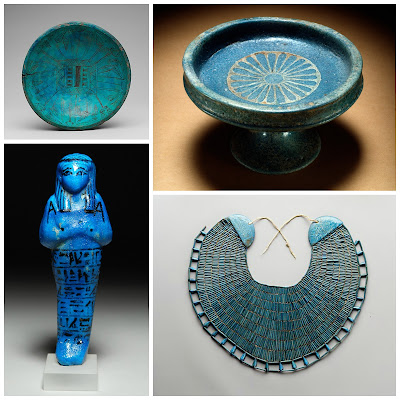 |
| Image: egyptological.com |
Welcome to the third, and final installment in the Ancient Egyptian amulet series. Today: the material faience. - prized for its intense blues and versatile for its inexpensive, even humble origins...
I think my interest in faience is twofold. I love clay, and the alchemy of firing and glazing. I am continually inspired by Art History. And that color! I could dive in and get lost. It really resonates with me...
 To the right is William. Have you "Met" him? (Art history humor! Forgive me...) He is a famous piece in the Metropolitan's Egyptian collection. He has his own page in the shop! How he became a celebrity I do not know - but he IS made of faience...
To the right is William. Have you "Met" him? (Art history humor! Forgive me...) He is a famous piece in the Metropolitan's Egyptian collection. He has his own page in the shop! How he became a celebrity I do not know - but he IS made of faience...
The Egyptian word for faience is "tjehnet" meaning "shining, dazzling". Archaeological evidence dates the use of faience to as early as 3500 BCE. It was developed as a substitute for lapis lazuli and was used for beads, amulets, statuettes, bowls...
 |
| Vessels, a shabti figure*, and a beaded netted collar. |
Comprised of finely ground quartz, lime, copper oxide, water, and a binder/gum arabic - this was a recipe of common ingredients, easily sourced in the area. The materials are mixed with water to form a paste, them molded or modeled and fired when dry. The paste is thixotropic - and hard to work with as it is much less plastic and malleable than clay. The interesting thing about this material ... it is self glazing! The term is "efflorescence of glazing" - glaze materials ( water soluble alkali salts) are mixed with quartz. As the water evaporates, the salts migrate to the surface, recrystallizing on the surface. When fired= glaze.
Knowing that - take a look at the detail in these amulets of Egyptian deities:
 In my research recently I have found recipes and may attempt mixing up a batch of Egyptian paste in the fall when I return to the Ceramics studio /classroom on my regular schedule. In the past I have used "Egyptian Paste" from art suppliers like Dick Blick. (At the writing of this article, I could not find this prepared version for sale. Recipes for making from scratch are readily available with a Google search.)
In my research recently I have found recipes and may attempt mixing up a batch of Egyptian paste in the fall when I return to the Ceramics studio /classroom on my regular schedule. In the past I have used "Egyptian Paste" from art suppliers like Dick Blick. (At the writing of this article, I could not find this prepared version for sale. Recipes for making from scratch are readily available with a Google search.)Its like trying to sculpt peanut butter - the consistency is so gooey! As per the ancient methods - I found bisqued ceramic molds the most user friendly: they are porous, and absorb moisture quickly, allowing the molded paste to release, and drop out easily.
 The challenge is patience. The paste is best left alone... as the crystals form on the surface as the piece dries. Sometimes patience is tough... Shown here are a few samples done when researching this material.
The challenge is patience. The paste is best left alone... as the crystals form on the surface as the piece dries. Sometimes patience is tough... Shown here are a few samples done when researching this material.I love the colors and the history of the materials. For all its quirks - I do think I am inspired to give it another go!
Thanks for following this exploration! I would love to hear what you think...
Until next time -
Jenny
www.jdaviesreazor.com
*The ushabti was a funerary figurine used in Ancient Egypt. Ushabtis were placed in tombs among the grave goods and were intended to act as substitutes for the deceased, should he/she be called upon to do manual labor in the afterlife. They were used from the Middle Kingdom (around 1900 BC) until the end of the Ptolemaic Period nearly 2000 years later.
References:



That color is spectacular and I love the pieces you made during your experimentation. I'm also totally in love with the beaded collar and William is adorable though we've never actually met!! :)
ReplyDeleteLike your recent scarabs as well - lets start a trend.
DeleteI was definitely an Egyptian in a past life....I love them all!
ReplyDeleteAnd I love that is it what regular folk like us would have worn...
DeleteLOVE this. I had a dream / vision once of a table full of faience and other Egyptian items. It was from the perspective of standing over it. This post reminded me of that. I want to try this too - do keep us posted of your findings!
ReplyDeleteI will! I have a stash of the pre-mix from my teaching days. I think I will mix a batch from scratch when I go back to the work studio. I have been having visions of cabs dance in my head - as the backs are unglazed...
DeleteVery cool post, Jenny! I love that blue...you should def do some more!
ReplyDeleteNot an art history major but always loved what I now know is called faience! I love that you can try and replicate it and can't wait to see what comes about!
ReplyDelete